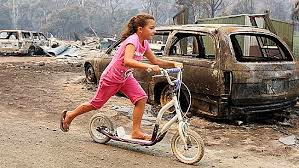Joseph Galbraith
Lesson 2 Reading Summary
Reference:
Muller, D. (2010). Ethics and trauma: lessons from media coverage of Black Saturday. The Australian Journal of Rural Health , 5-10.
Theme: The actions of the media during the Black Saturday disaster has left many questions regarding ethical behavior. The interaction with emergency services authorities and survivors must be improved to keep journalistic integrity.
Summary:
• The research article interviews 28 members of the media that covered the brush fires in February, 2009 in Victoria, Australia. The purpose was to find out how the media reacted to roadblocks, authorities and survivors. The after effects on the media employees were were also examined.
• The authorities set many roadblocks after the disaster specifically to keep media members distanced from the scene. Different media organizations reacted differently to this measure. The following tactics were used by the media.
-Find another way in
-Get past by chance
-Get past by deception
- Resist Deception
- Accept the road block
• There was no general consensus by the media industry on how to deal with restrictions.
• Many journalists did not believe that the roadblocks were there to protect their safety. Many believed that the authorities were trying to protect the survivors.
• Media members were also faced with whether or not to access private property to get a story. Different tactics were used with many reasons for doing so, including getting the real story to the public.
• More consensuses were agreed upon when it came to interviewing survivors. Prior consent was requested for interviews and images. Close up coverage was avoided during times intimacy and grief. Also, when interviewed, survivors were given a fairness test before being broadcast. Fairness means that the media member would have to determine if the answers given were affected by the emotion caused by the event and would the person answer different at a later time. It was suggested that media members undergo training by trauma experts to understand how certain questions can affect survivors negatively.
•Another ethical issue was raised during this disaster of when should a reporter put down the camera and help the victim. Is he or she contributing more by covering the story or by assisting?
• The different actions by the various news organizations were caused by; rivalries, authorities, editors and the survivors that they dealt with. Some survivors wanted to talk to the media because it helped them cope.
• Much still must be learned by media organizations on how to help employees cope with trauma.
Application to the lesson topic:
This article applied ethical questions to the media and emergency services and sparked more discussion on ethical standards.
Application to emergency services: Emergency responders must try to stay professional when dealing with the media. Even when the media is at fault for an unethical action, they will not report on it. Instead the emergency personnel will be scrutinized unfairly. Proper planning and understanding the ethical standards in place by the media will help emergency organization accomplish their tasks more efficiently.

No comments:
Post a Comment
Note: Only a member of this blog may post a comment.